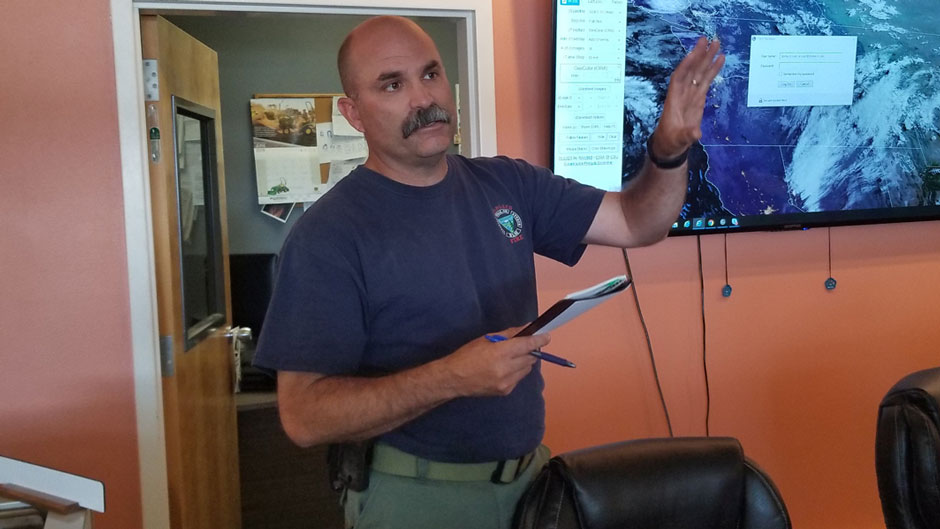Al Crouch, fire mitigation/education specialist for the Vale District of the BLM talks about the upcoming fire season during an interview recently. (The Enterprise/Pat Caldwell).
UPDATED WITH VIDEO: BLM crew training
VALE – Calculating the severity of a fire season is a guessing game.
Fire officials can measure water moisture in soils and grasses, review data from the past and cast a wary eye on the weather.
In the end, though, Mother Nature will determine how many fires will erupt across the local region and she plays her cards close to the vest.
“Most of the fires that typically happen in the BLM’s jurisdiction are caused by lightning and its anyone’s guess how many fires will ignite,” said Al Crouch, fire mitigation/education specialist for the Vale District of the U.S. Bureau of Land Management.
Last year the BLM responded to 29 fires in Malheur County that burned about 14,530 acres. Both the number of fires and the total acres scorched were below the 10-year average, said Crouch.
He said indications show the upcoming fire season will be normal, or moderate.
“But that can change throughout the summer,” said Crouch.
The severity of a fire season depends on a host of factors that make predictions difficult, said Crouch. Crouch said fire seasons “ebb and flow nationally, regionally and locally.”
“Typically, in eastern Oregon – as far as BLM lands are concerned – elevation, timing and amounts of spring rains and grass growth have lot to do with the onset and potential severity of fire season,” said Crouch.
He said usually lower-elevation areas “come into fire season first.”
“These areas experience hotter temperatures and wildland fuels begin to dry sooner and faster. As the summer months progress, fire season extends vertically through the elevations but also laterally across the landscape,” said Crouch.
He said that scenario is playing out across the region now.
“Lower elevations around population centers and recreation areas are drying fast, with higher elevations that are still wet, green and growing,” said Crouch.
Because of the wet spring, Crouch said dry sagebrush – which is usually a key ingredient to big range fires – won’t be a factor soon.
“The district received a lot of moisture this spring and the sagebrush soaked it up like a sponge,” said Crouch. “So, it’s difficult to say what this fire season overall has in store for us.”
A long period of hot weather coupled with thunderstorms usually produces fires, said Crouch.
“Typically, there is a direct correlation to the amount of lightning and number of fires, especially if that lightning occurs with little to no moisture associated with the storms,” said Crouch.
Jess Tolman, Vale City & Rural Fire Department chief, said it is too early to assess the 2019 fire season.
“There is a lot of grass out there, though, and if this rain stops and we get to 100 degrees and it stays that way for a long period of time there could be a chance for huge fire season,” said Tolman.
Crouch said Mother Nature is a wild card every year but human-caused fires – which are on the rise – can be diminished.
“The number of human-caused fires per year are on the rise across the district. It’s up to all of us to do our part to help reduce human-caused ignitions and improve the survivability and defend ability of our homes and infrastructure,” said Crouch.
Crouch said in 2017 there were 16 human-caused fires but climbed to 18 in 2018.
“So far, this year we’re already at seven for the calendar year,” said Crouch. “In recent years, we have experienced a large amount of equipment-caused fires, which is by far the leading human-caused category on the district,” said Crouch.
The majority of those equipment-caused fires, said Crouch, are from vehicles.
Crouch said locally the fire season ramps up between mid-July and the middle of August.
“We can get short periods out of that time frame when conditions are primed for large fires,” said Crouch.
Crouch said the Vale BLM office is hoping for the best for this fire season but preparing for an active summer.
“Our staff here trains and prepares for the worst every year. We will staff to our maximum capabilities commensurate with the fire conditions present,” said Crouch.
The Vale BLM can deploy a solid arsenal of fire-fighting resources.
Now there are 15 engines, a hotshot crew, seven Snake River Valley fire crews, a helicopter, two bulldozers and an array of other logistical and command units ready. The Vale BLM is also linked to other federal and state agencies for additional resources, said Crouch.
“Our district fire program is integrated in many ways, locally and regionally.
This includes, but is not limited to, fire planning, fuel reduction efforts, fire simulation exercise, fire training, fire prevention and risk reduction projects,” said Crouch.
An important part of that integration includes area Rangeland Fire Protection Associations, or RFPAs.
RFPA consist of local landowners who volunteer to fight fires near their homes.
There are Rangeland Fire Protection Associations in Ironside, Jordan Valley, Vale and Juntura.
Reporter Pat Caldwell: [email protected] or 541-473-3377.
SUBSCRIBE TO HELP PRODUCE VITAL REPORTING — For $5 a month, you get breaking news alerts, emailed newsletters and around-the-clock access to our stories. We depend on subscribers to pay for in-depth, accurate news produced by a professional and highly trained staff. Help us grow and get better with your subscription. Sign up HERE.





